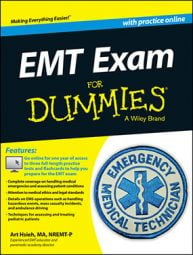Begin by discarding answers that are clearly incorrect. On the NREMT exam, answers that are obviously wrong may not appear often, but when they do, make the most of it and get rid of them. It’s better to make an educated guess when you have three possibilities rather than four!
If you’re not lucky enough to remove an obvious incorrect answer, read each choice carefully. Consider whether what you read has some relationship to the stem and make a mental judgment as to how likely that answer is to be the best one.
You may grade the choice as “very unlikely,” “maybe,” or “very likely.” Repeat this process for each choice. When you’re done, sort the responses according to how likely they are to be the best answer. The one that comes to the top of your list is likely your best answer.
A 20-year-old female was struck in the chest with a bat during a fight. She complains of chest pain and trouble breathing. There is tenderness when you palpate the left anterior chest wall, in the area of T3 and T4. Lung sounds are clear and equal on inspiration. She is alert and breathing 20 times per minute. Her pulse rate is 90. Which of the following injuries is most likely?
(A)Tension pneumothorax
(B)Rib fractures
(C)Pneumothorax
(D)Pulmonary contusion
Given the mechanism of injury, any of the choices could be correct. However, you would expect to see additional findings in the stem for most of the responses. For example, you’d expect to see tachycardia, hypotension, altered mental status, and jugular venous distension for Choice (A), which makes it very unlikely.
While Choice (C) is possible, you’d expect a faster breathing rate and/or a difference in lung sounds on the affected side, making this choice less likely. You’d also expect tachypnea with Choice (D). This line of thinking leaves Choice (B) as the most likely answer.
The following are common mistakes test-writers make that good test-takers recognize, sometimes unconsciously. However, the writers of the NREMT exam work really hard to eliminate these issues; as a result, the vast majority of the test items really test your knowledge and not your test-taking abilities.
If the answer contains absolute words, such as never and always, it’s not likely to be correct. Virtually no situations are so clear-cut.
If the answer doesn’t grammatically key into the stem, it’s probably not right.
The correct choice may be the longest one. That’s because the test-writer provides an explanation or extra details to make it the best answer.
Sometimes a word or phrase appears in the stem and is repeated within an answer. If so, it may point to the correct response.
Remember that these are not hard and fast rules. For example, the test-writer may intentionally put the same word in both the stem and in a wrong answer, just to mislead you.

